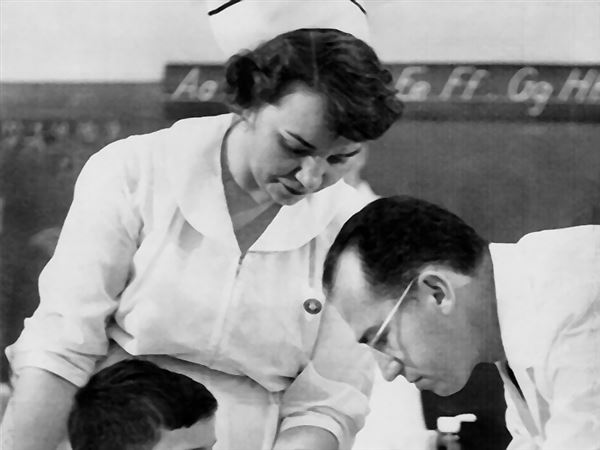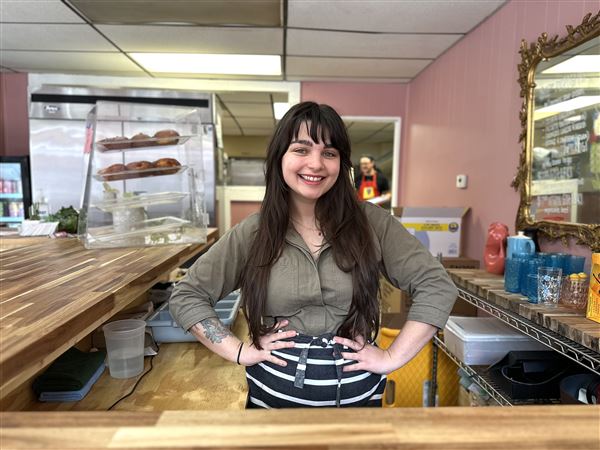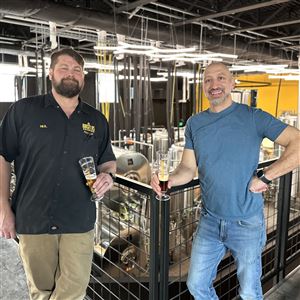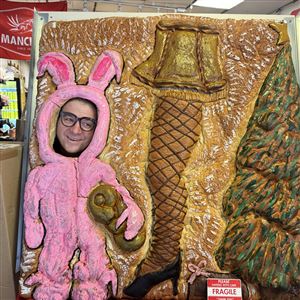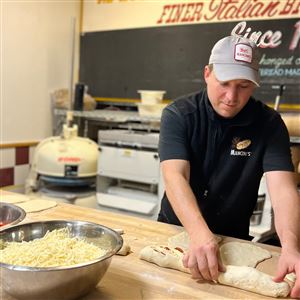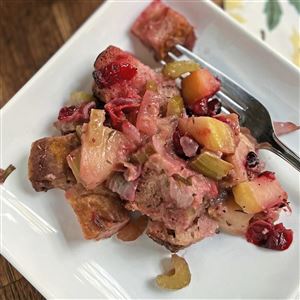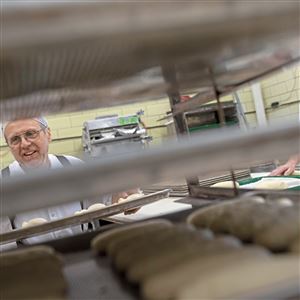James “Jimmy” Mancini was just 5 years old when he and his mother, Maria, immigrated from Southern Italy’s Abruzzo region in 1911.
The oldest in what would eventually become a family of eight children, he never could have imagined that within 10 years, he would be wrist-deep in dough, perfecting the right combination of flour, water, yeast and sugar to create a loaf of twisted Italian bread that would become iconic in Pittsburgh.
And he certainly never would have guessed the tiny bakery he would open in a pale-orange brick storefront on a side street in Stowe would stand the test of time, baking essential eats for generations of Pittsburghers.
Before Jimmy was born, his father, Frank, left the small village of Sant'Eufemia a Maiella in search of a better life and found work in McKees Rocks as a machinist.
Father and son never really got along once Jimmy and his mother arrived in Pittsburgh. So, at 14, Jimmy moved out of the house to apprentice himself to a local baker.
An industrious boy who reveled in making bread at night to sell the next day, Mancini would eventually start his own bakery in a garage, “somewhere around here, maybe in the Bottoms?” his grand-nephew Nick Mancini Hartner pondered on a recent Tuesday about the part of town that stretches along the Ohio River to the McKees Rocks Bridge.
Wherever he baked those first crusty, aromatic loaves, it did well enough that, in 1926, Frank Mancini agreed to build the one-room Mancini’s Bakery on Woodward Avenue for his son, then 20.
It’s been churning out countless loaves of bread every day of the week ever since, becoming so successful that Hartner, a third-generation co-owner, opened a satellite location on Penn Avenue in the Strip District in 2002.
Known for its best-selling pepperoni rolls, hoagie sticks and other familiar products, the 15-foot-wide, 1,400-square-foot bakery — often used as a test kitchen for the main bakery — is almost as famous as the original.
“It went from a one-man show to an eight-man to now a 52-man show” that cranks out some 10,000 loaves a day, says Hartner, 46, of Franklin Park. “It’s a big accomplishment.”
“It’s the staff of life,” agrees his 77-year-old mother, Mary Mancini Hartner, who gave up a career in banking at age 30 to work at the bakery alongside her father, Ernie, who became his brother Jimmy’s business partner in the 1940s.
All in the family
Neither mother nor son planned for a career that would rise around bread. Mary Hartner was a dress buyer at Kaufmann’s before earning her MBA at the University of Pittsburgh and getting a job with Equibank; her son studied biomedical engineering at Marquette University and dreamed of a career in prosthetics.
But it was probably inevitable.
Jimmy Mancini’s youngest brother, Ernie, who grew up in The Rocks, made the bakery a family business when he reluctantly took the reins after serving in the Air Force in World War II instead of going back to college.
After divorcing his first wife in 1945, Jimmy — who never had children — decided to head to California to start another bakery and asked Ernie to take over. When the venture failed — the group of guys he headed west with “wanted to spend all their time playing golf,” Hartner says — he returned to Pittsburgh and told his brother, “Thanks!”
But by then, Ernie had fallen in love with the art of bread making and insisted they become partners. So they ran the bakery together until Jimmy died of lung cancer in 1977.
Ernie had planned on handing the business down to his 28-year-old son, Frank, who had started working at the bakery in the early ’70s, even though Mary expressed an interest in coming on board.
“But dad said, ‘Oh no, it belongs to your brother. It’s time for you to have children,’” she recalls with a chuckle.
Due to a tragic turn of fate, the bakery would come to her anyway.
When her brother was killed in a motorcycle accident in July 1977, Mary stepped in to keep the bakery running by doing the books and managing payroll. She worked alongside her dad for the next 25 years and took over completely upon her father’s death in 2004. (Her younger sister, Amy, pursued other interests after being bought out of the business.)
Mary’s son Nick, who grew up in his grandmother’s house in Windgap, came into the fold in 2000, when he couldn’t find a job after college.
She suggested he work at the bakery for a year to see if it was something he might want to do. After shadowing journeymen bakers on the night shift in Stowe, he was surprised to find he, too, had fallen in love with bread making.
Millions of loaves later, he’s still smitten by the business of dough, both running the bakery and writing recipes for its artisan loaves. A fan of “bread art” since he was a kid — he would often play around with dough his mom brought home from the bakery — he also occasionally creates bread sculptures for display during the holidays to grab people’s attention.
“It was our Play-Doh,” he says. “We would make it into shapes , bake it then eat it.”
Staying on trend
Mancini’s signature twist Italian bread is still made using the same recipe and Old World technique as in 1926. Making each loaf involves flipping a yard-long strand of dough over and under by hand and then tucking the ends under to create its iconic shape.
And it still takes almost four hours start to finish. Each loaf undergoes two fermentations, after which it is proofed in a dedicated proofing cabinet and then baked anywhere from 16 to 40 minutes, depending on size.
While Ernie Hartner was reluctant to mess with success and adopt new technologies — the bakery waited until 2002 to replace its original coal-fired oven with a natural gas-fired oven that can make 288 loaves of bread every half-hour — he did want to see the business grow.
The original location has expanded eight times by punching through walls to become a 10,000-square-foot facility complete with six loading docks along a rear alley.
In a room that holds four giant flour bins that are each filled with 25 tons of flour every five or six days, you can still see a set of stairs leading to the second floor of an old house.
“My dad bought the house [next door], gutted it and literally cut a hole in the floor” to make room for the massive containers, says Mary Hartner.
To keep up with demand, the Stowe bakery boasts two giant mixers that can mix up to 500 pounds of dough for 400 loaves at a time, two smaller mixers for specialty breads, three different proofers, and 10 rack ovens that bake at 400 degrees, filling the space with the intoxicating scent of baking bread.
“And by 10 p.m., every single rack is being used,” says Nick Hartner.
It’s a far cry from 99 years ago, when Jimmy Mancini’s one-man operation could bake around 90 loaves of his twisted Italian bread per night in the one-room bakery now used just for customer sales.
All told, the bakery mixes, shapes and bakes about 20 different doughs into around 50 shapes and sizes, says Nick Hartner. And its ovens, fans and other equipment keep humming 24/7. Mancini’s is the last remaining bakery that delivers seven days a week in Pittsburgh, except for on major holidays.
All around town
Made from hard red spring wheat grown in the Midwest and milled in Buffalo, N.Y., Mancini’s bread sits on shelves practically everywhere across the city. It’s found in Giant Eagle, Shop ‘n Save, Kuhn’s and Labriola’s, along with restaurants including Fiori’s, Mama Lena’s, Mineo’s and Burgatory, where burgers come stuffed in its brioche buns.
You’ll also find its bread and pepperoni rolls at events like the U.S. Open Golf Championship, held this year at Oakmont Country Club on June 12-15, and its bread also is at the Home Plate Club at PNC Park.
“Uncle Jimmy always said to keep [customers] hungry so you don’t flood the market,” Mary Hartner says, “but Dad was a little more entrepreneurial and wanted to grow.... He was very proud of what he’d done.”
To that end, the bakery has added trendy loafs like multigrain, sourdough, rye and cranberry walnut, along with paska, Irish soda bread and other seasonal breads to keep up with the competition and customers’ evolving tastes. It also offers a line of sauces and spreads made by Dei Fratelli in Johnstown, N.Y. under the Mancini’s label. And last summer, it introduced a bun made with Iron City Beer.
“We would hear from customers, ‘Can you do this for me?’” Nick Hartner says. “We felt we needed to compete on the terms of today’s market.”
One big modification was fueled by the COVID-19 pandemic, when paper bags were in short supply. While its signature Italian twists still come in their iconic white paper bags, Mancini’s today packages about 60% of its product in micro-perforated polypropylene bags, compared to just 10% in 2004, the year the bakery put in a slicer. (Thousands of tiny pin-sized holes keep the bread crusty, and fresher longer.)
As she ponders her eventual retirement, Mary Hartner says she’s hopeful Mancini’s will continue to fill Pittsburgh’s bread baskets for years to come.
“Every other place I’ve ever worked at is gone now,” she says, “so I hope this stays.”
Pausing to take a look around the staging area, where thousands of loaves of bread await being loaded into trucks, she adds, “It’s crazy how much [the bakery] has changed but still speaks to its history.”
One sign Mancini’s might buck the trend and survive into a fourth generation: All three of Nick’s children do events and occasionally help out in the bakery.
“So hopefully one of the three will take over,” he says with a laugh.
First Published: February 28, 2025, 10:30 a.m.
Updated: March 3, 2025, 1:41 p.m.



